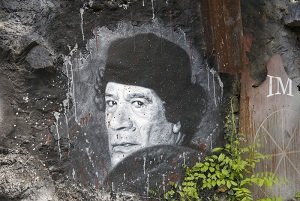 If one was to write about Gaddafi’s life in periods, they could point out the three of them — pan-Arab, Islamist, and pan-African. They would be accompanied with speeches, beliefs, and the clothing style. A charismatic ruler, Muammar Gaddafi was a dictator above all. From the very beginning of his rule in the late 1960s and until his death in 2010, he made Libya a wealthy country whose own people did not see any of this wealth. He managed to win the hearts of many powerful people around the world, but his actions against his own people should be not forgotten.
If one was to write about Gaddafi’s life in periods, they could point out the three of them — pan-Arab, Islamist, and pan-African. They would be accompanied with speeches, beliefs, and the clothing style. A charismatic ruler, Muammar Gaddafi was a dictator above all. From the very beginning of his rule in the late 1960s and until his death in 2010, he made Libya a wealthy country whose own people did not see any of this wealth. He managed to win the hearts of many powerful people around the world, but his actions against his own people should be not forgotten.
Gaddafi gained his power in a military coup in 1969; back then, he was a 27-year old military officer. Just like his Egyptian “colleague”, President Gamal Abdel Nasser, he was against the foreign presence in his region. At that time, there were oil reserves found in Libya, and international companies owned the oil production facilities and got a large share of the revenue. Gaddafi started the coup, which resulted in Libya regaining all its oil facilities. Soon after Libya’s success, other neighboring countries did the same. Gaddafi managed to make Libya a rich country mainly because of its small population and significant oil resources.
Right after becoming the country’s leader, Gaddafi wrote a book where he outlined his political theory and beliefs. It was called “The Green Book”, and its main focus was a blend between communism and capitalism aimed at liberating the oppressed people through the means of revolution. In “The Green Book”, the power belonged to people and people’s committees which they attended. The committees were created to communicate the people’s will to the central governmental apparatus.
In reality, Gaddafi was far from a tolerant ruler, and those who disagreed with his theory were eliminated. The apparatus consisted of Gaddafi himself and his close people, and the committees were just a lure for the masses. In truth, any deviation from the leader’s theory and beliefs on how Libya has to be structured within met legal sanctions, such as corporal punishment, life imprisonment, and even death. There were also illicit measures taken against insurgents, such as kidnapping, tortures, and other. This resulted in the mass abandonment of the country by the intellectual elites, if not elimination of such by the state, and further persecution of them abroad.
The world’s governments turned away from Gaddafi and his dictatorship for some time. Bombing of a Berlin-based club in 1986 was when the patience ceased. The US, whose president at the time was Ronald Reagan, performed a series of attacks on Tripoli and Benghazi. The US did not achieve anything by the air strikes, and the West turned away from Libya for two more years. In 1988, a plane crash near the town of Lockerbie, Scotland was a terrorist act by the Libyans. While the UK was outraged with the tragedy, some sanctions and decade-long negotiations were all that the country could do. The outcome was the trial of two Libyan terrorists in 1999, one of whom was found not guilty.
In 2003, after the US invaded Iraq and hanged its dictator Saddam Hussein, Muammar Gaddafi stopped his claims of nuclear and chemical weapons and engaged in diplomacy with the US and EU. Gaddafi visited a number of countries with his bedouin tent and female bodyguards. While attending meetings of the world’s rulers, the Libyan dictator allowed eccentricities like no one else. One of them was his famous over-an-hour-long speech at the UN General Assembly in 2009.
In 2010, the people of Libya rebelled against their long-term leader and dictator Muammar Gaddafi. They were joined by the UN troops, and together, they first forced Gaddafi into exile and then killed him with either an air strike or a mob punishment. The circumstances of the dictator’s death are unknown, but his 40-something rule came to an end resulting in liberation of the country from Gaddafi’s and his family’s dictatorship. Although Gaddafi can be called a charismatic ruler and compared to Picasso in his eccentricity, it should be remembered that his rule came at a great price: numerous lives of innocent Libyans.
References
- Al-Gathafi M. The Green Book: The Solution to the Problem of Democracy; The Solution to the Economic Problem; The Social Basis of the Third Universal Theory. UK: Ithaca Press, 2005.
- Blundy D, & Lycett A. Qaddafi and the Libyan Revolution. Boston and Toronto: Little Brown & Co, 1987.
- Gardell M. Gods of the Blood: The Pagan Revival and White Separatism. Durham and London: Duke University Press, 2003.
- Geldenhuys D. “The rule-breaking conduct of Qaddafi’s Libya”. Strategic Review for Southern Africa (Strategic Review for Southern Africa), 2003.
- Human Rights Watch. Death of a Dictator: Bloody Vengeance in Sirte. 2012.
- Pargeter A. Libya: The Rise and Fall of Qaddafi. New Haven: Yale University Press, 2012.
- Street J. “Celebrity Politicians: Popular Culture and Political Representation.” British Journal of Politics and International Relations, 2004.
Vandewalle D. Libya Since 1969: Qadhafi’s Revolution Revisited. Palgrave Macmillan, 2011.
